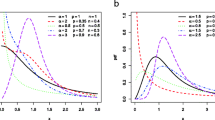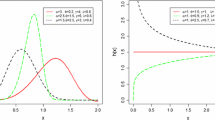Abstract
The log-normal and the log-logistic distributions are two of the most commonly used distributions for studying positively skewed lifetime data. Both the distributions share number of interesting properties, and for a certain range of parameters their cumulative and hazard functions can also be similar in nature. However, selecting a more appropriate distribution and discriminating among them for a given data to best fit is an important issue. Further, when the data are observed in the presence of some censoring scheme the problem becomes more challenging. In this paper, we address the problem of selecting a more appropriate distribution by discriminating based on the random samples drawn in the presence of type-II censoring. We consider the difference of the maximized log-likelihood functions, and compute the asymptotic distribution of the discrimination statistic. We further propose a modified discriminating approach, and compute the probabilities of correct selection to check the performance of the discrimination procedure. Finally, simulation study is conducted, and two real data sets are analysed for the illustration purpose.





Similar content being viewed by others
References
Abid R, Kokonendji CC (2021) Choice between and within the classes of poisson-tweedie and poisson-exponential-tweedie count models. Communications in Statistics-Simulation and Computation, pp 1–20
Arabi Belaghi R, Noori Asl M, Singh S (2017) On estimating the parameters of the Burr xii model under progressive type-i interval censoring. J Stat Comput Simul 87(16):3132–3151
Ashkar F, Aucoin F (2012) Discriminating between the lognormal and the log-logistic distributions for hydrological frequency analysis. J Hydrol Eng 17(1):160–167
Balakrishnan N, Mi J (2003) Existence and uniqueness of the mles for normal distribution based on general progressively type-ii censored samples. Stat Probab Lett 64(4):407–414
Bhattacharyya GK (1985) The asymptotics of maximum likelihood and related estimators based on type ii censored data. J Am Stat Assoc 80(390):398–404
Bromideh AA (2012) Discriminating between Weibull and log-normal distributions based on Kullback-Leibler divergence. Istanbul Univ Econom Stat e-J 16:44–54
Cain SR (2002) Distinguishing between lognormal and Weibull distributions [time-to-failure data]. IEEE Trans Reliab 51(1):32–38
Cox DR (1961) Tests of separate families of hypotheses. Proc., Fourth Berkeley Symp. in Mathematical Statistics and Probability, pp 105–123
Cox DR (1962) Further results on tests of separate families of hypotheses. J Roy Stat Soc: Ser B (Methodol) 24(2):406–424
Dey AK, Kundu D (2009) Discriminating among the log-normal, Weibull, and generalized exponential distributions. IEEE Trans Reliab 58(3):416–424
Dey AK, Kundu D (2009) Discriminating between the log-normal and log-logistic distributions. Commun Stat-Theory Methods 39(2):280–292
Dey AK, Kundu D (2012) Discriminating between the Weibull and log-normal distributions for type-ii censored data. Statistics 46(2):197–214
Dumonceaux R, Antle CE, Haas G (1973) Likelihood ratio test for discriminagon between two models with unknown location and scale parameters. Technometrics 15(1):19–27
Fearn D, Nebenzahl E (1991) On the maximum likelihood ratio method of deciding between the Weibull and gamma distributions. Commun Stat-Theory and Methods 20(2):579–593
Gupta RC, Kundu D (2003) Discriminating between Weibull and generalized exponential distributions. Comput Stat Data Anal 43(2003):179–196
Gupta RC, Akman O, Lvin S (1999) A study of log-logistic model in survival analysis. Biometrical J: J Math Methods Biosci 41(4):431–443
Johnson NL, Kotz S, Balakrishnan N (1995) Continuous univariate distributions, volume 2 (Vol. 289), John wiley & sons
Kundu D, Gupta RD, Manglick A (2005) Discriminating between the log-normal and generalized exponential distributions. J Stat Plann Inference 127(1–2):213–227
Kundu D, Manglick A (2004) Discriminating between the Weibull and log-normal distributions. Naval Res Logistics (NRL) 51(6):893–905
Kus C, Kaya MF (2006) Estimation of parameters of the loglogistic distribution based on progressive censoring using the em algorithm. Hacettepe J Math Stat 35(2):203–211
Lawless JF (2011) Statistical models and methods for lifetime data. John Wiley & Sons
Linhart H, Zucchini W (1986) Model selection. Wiley, New York
Marsh HW, Hau K-T, Wen Z (2004) In search of golden rules: comment on hypothesis-testing approaches to setting cutoff values for fit indexes and dangers in overgeneralizing hu and bentler’s (1999) findings. Struct Equ Model 11(3):320–341
Pan W (2002) Goodness-of-fit tests for gee with correlated binary data. Scand J Stat 29(1):101–110
Quesenberry C, Kent J (1982) Selecting among probability distributions used in reliability. Technometrics 24(1):59–65
Quesenberry CP (1982) Selecting among Weibull, lognormal and gamma distributions using complete and censored smaples. Naval Res Log Q 29(4):557–569
Raqab MZ, Al-Awadhi SA, Kundu D (2018) Discriminating among Weibull, log-normal, and log-logistic distributions. Commun Stat-Simul Comput 47(5):1397–1419
Roshan S, Mohan BR, Kumar M, Vandanapu N (2017) Model selection among log-normal, Weibull, gamma and generalized exponential distributions. In 2017 6th International Conference on Reliability, Infocom Technologies and Optimization (Trends and Future Directions)(ICRITO), pp 321–325. IEEE
Singh S, Arabi Belaghi R, Noori Asl M (2019) Estimation and prediction using classical and bayesian approaches for Burr iii model under progressive type-i hybrid censoring. Int J Syst Assur Eng Manag 10(4):746–764
Singh S, Tripathi YM (2015) Bayesian estimation and prediction for a hybrid censored lognormal distribution. IEEE Trans Reliab 65(2):782–795
Tregouet D, Escolano S, Tiret L, Mallet A, Golmard J (2004) A new algorithm for haplotype-based association analysis: the Stochastic-EM algorithm. Ann Hum Genet 68(2):165–177
Zhang M, Ye Z, Xie M (2014) A Stochastic EM algorithm for progressively censored data analysis. Qual Reliab Eng Int 30(5):711–722
Acknowledgements
Authors express their sincere gratitude to anonymous reviewers for their constructive suggestions on the earlier version of this manuscript. We also thank the Editor and an Associate Editor for their encouraging suggestions. First Author thanks the University Grants Commission, Ministry of Education, Govt. of India to provide financial support [No.F.40-2/2019 (NET/Fellowships)] and Central University of Haryana to provide research platform to carry out this research work.
Author information
Authors and Affiliations
Corresponding author
Additional information
Publisher's Note
Springer Nature remains neutral with regard to jurisdictional claims in published maps and institutional affiliations.
Appendices
Appendix A
Proof of Lemma 1
The use of the Theorems 1 and 2 of Bhattacharyya (1985) will easily establish the proof of parts (i) and (ii) of Lemma 1. Further, it can be observed that log-normal distribution satisfies the regularity conditions of Theorem 1 and 2. Now, we proceed in the following way to prove part (iii) of Lemma 1. Observe that, from (6) and part (iii) of Lemma 1, we have
where \(\beta =(\sigma ,\mu ,\gamma ,\xi )^T, {\hat{\beta }}=({\hat{\sigma }},{\hat{\mu }},{\hat{\gamma }},{\hat{\xi }})^T, g(x_{i}, \beta )=\ln \left( \frac{f_{LN}(x_{i},\sigma ,\mu )}{f_{LL}(x_{i}, \gamma ,\xi )}\right) , h(x_{r},\beta )=\ln \left( \frac{1- F_{LN}(x_{r},\sigma ,\mu )}{1-F_{LL}(x_{r},\gamma ,\xi )}\right)\), and \({{\tilde{\beta }}}=(\sigma ,\mu ,{{\tilde{\gamma }}},{{\tilde{\xi }}})^T\). Now, our main objective is to show
Here, \(\overset{P}{\rightarrow }\) stands for convergence in probability. Now, to prove equation (16), it will be enough to prove
Now, using (14) and (15), \((1/\sqrt{n})\left( T_r-T_*\right)\) can be written as
Here \(\overset{a.e.}{=}\) and \(o_p(1)\), stands for asymptotically equivalent and convergence in probability to zero respectively, where \(g'_j=\left( \frac{\partial }{\partial \beta _j}\right) g(.), h'_j=\left( \frac{\partial }{\partial \beta _j}\right) h(.),{\hat{\beta _j}}\) and \({{\tilde{\beta }}}_j\) are the \(j^{th}\) components of \({{\hat{\beta }}}\) and \({{\tilde{\beta }}}\) respectively for \(j = 1, 2, 3, 4\). It should be noted that the second equality is produced using the Theorem 2 of Bhattacharyya (1985), as \(\sum _{i=1}^{n}g(x_i;.)\cdot 1_{x_i\le \alpha }\) and \(\sum _{i=1}^{n}g(x_i;.)\cdot 1_{x_i\le x_{r}}\) are asymptotically equivalent. Now, with the implementation of the weak law of large numbers and the fact that \(h'(.)\) is a continuous function, we have,
Now, following the same line as Fearn and Nebenzahl (1991), we have
Therefore, using dominated convergence theorem, we can write
Now, equation (17) follows from the use of equation (21), and \(\sqrt{n}({\hat{\beta _j}}-{{\tilde{\beta }}}_j)\) converges to a normal distribution with mean zero and finite variance. Next, to prove (18), by making use of (19), observe that
Therefore, by using equations (20) and (21), it is observed that
Since, \(\lim _{n\rightarrow \infty }E_{LN}\left( \sqrt{n}({\hat{\beta _j}}-{{\tilde{\beta }}}_j) \right) ^2<\infty ~\forall ~ j = 1, 2, 3, 4\), and therefore equation (18) follows. \(\square\)
Appendix B
\(T_*\) is independent of the parameters of the parent distributions
Here, we show numerically that the values of \(T_*\) are not dependent on the parameters but only depends on the censoring proportion p. We, consider the case of the log-normal distribution. We used the results of Lemma 1 for calculating the values of \(T_*\) for different values of \(\sigma\) and \(\mu\), the shape and the scale parameters of the log-normal distribution, for different censoring proportions, p= 0.9, 0.8, 0.7, 0.6, 0.5, 0.4 and 0.3. The tabulated values of \(T_*\) are presented in Table 11, and from the reported values, it can be observed that the values of \(T_*\) remains more or less same for different values of \(\sigma\) and \(\mu\) for the particular value of p. But it changes as we change the value of p. Hence, we can conclude based on the numerical observations that \(T_*\) values only depend on p and are independent of the values of the parent parameters. This also holds true when the log-logistic distribution is considered as parent distribution.
Rights and permissions
Springer Nature or its licensor (e.g. a society or other partner) holds exclusive rights to this article under a publishing agreement with the author(s) or other rightsholder(s); author self-archiving of the accepted manuscript version of this article is solely governed by the terms of such publishing agreement and applicable law.
About this article
Cite this article
Diyali, B., Kumar, D. & Singh, S. Discriminating between log-normal and log-logistic distributions in the presence of type-II censoring. Comput Stat 39, 1459–1483 (2024). https://doi.org/10.1007/s00180-023-01351-7
Received:
Accepted:
Published:
Issue Date:
DOI: https://doi.org/10.1007/s00180-023-01351-7




